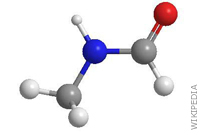Rotational Spectroscopy, Tentative Interstellar Detection, and Chemical Modelling of N-methylformamide

N-methylformamide, CH3NHCHO, may be an important molecule for interstellar pre-biotic chemistry because it contains a peptide bond.
The rotational spectrum of the most stable trans conformer of CH3NHCHO is complicated by strong torsion-rotation interaction due to the low barrier of the methyl torsion. We use two absorption spectrometers in Kharkiv and Lille to measure the rotational spectra over 45–630 GHz. The analysis is carried out using the Rho-axis method and the RAM36 code. We search for N-methylformamide toward the hot molecular core Sgr B2(N2) using a spectral line survey carried out with ALMA. The astronomical results are put into a broader astrochemical context with the help of a gas-grain chemical kinetics model.
The laboratory data set for the trans conformer of CH3NHCHO consists of 9469 line frequencies with J <= 62, including the first assignment of the rotational spectra of the first and second excited torsional states. All these lines are fitted within experimental accuracy. We report the tentative detection of CH3NHCHO towards Sgr B2(N2). We find CH3NHCHO to be more than one order of magnitude less abundant than NH2CHO, a factor of two less abundant than CH3NCO, but only slightly less abundant than CH3CONH2. The chemical models indicate that the efficient formation of HNCO via NH + CO on grains is a necessary step in the achievement of the observed gas-phase abundance of CH3NCO.
Production of CH3NHCHO may plausibly occur on grains either through the direct addition of functional-group radicals or through the hydrogenation of CH3NCO. Provided the detection of CH3NHCHO is confirmed, the only slight underabundance of this molecule compared to its more stable structural isomer acetamide and the sensitivity of the model abundances to the chemical kinetics parameters suggest that the formation of these two molecules is controlled by kinetics rather than thermal equilibrium.
A. Belloche, A. A. Meshcheryakov, R. T. Garrod, V. V. Ilyushin, E. A. Alekseev, R. A. Motiyenko, L. Margulès, H. S. P. Müller, K. M. Menten
(Submitted on 17 Jan 2017)
Comments: Accepted for publication in A&A. 41 pages, 30 figures, 13 tables. The abstract has been shortened to comply with the size limit set by arXiv
Subjects: Astrophysics of Galaxies (astro-ph.GA)
Cite as: arXiv:1701.04640 [astro-ph.GA] (or arXiv:1701.04640v1 [astro-ph.GA] for this version)
Submission history
From: Arnaud Belloche
[v1] Tue, 17 Jan 2017 12:15:15 GMT (2132kb)
https://arxiv.org/abs/1701.04640








